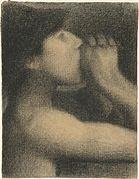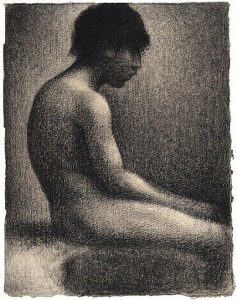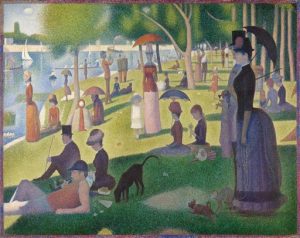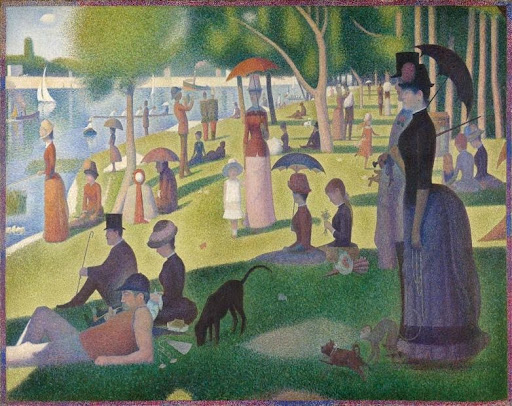
L’Écho, (Bathing Place, Asnières), 1883–84
Georges Seurat was born in Paris in 1859. His parents, Chrysostome-Antoine Seurat and Ernestine Faivre, were bailiffs. Seurat’s father was a wealthy man, but he lived 12 kilometers outside of Paris, while his mother, brother, and sister remained in the city with him. They later relocated to Fontainebleau during the Franco-Prussian War. His maternal uncle, Paul Haumonté, a painter, gave him informal art lessons as a child, which inspired him. It is possible to categorize his art career into three stages: early, mid, and late.

Seated Nude, Study for Une Baignade, 1883
Early
Municipal Art School as a student of Justin Lequien in 1875. While in art school, he spent most of his time in museums and libraries. In April 1879, he saw two Impressionist artists, Claude Monet and Camille Pissarro, which influenced his later experimentation on seascapes, street scenes, and other subjects in Brest.

Bathers at Asnières, Pointillism, 1884
Mid
Between 1881 and 1884, Seurat painted his first significant project, Bathers at Asnières. On the massive canvas, he depicts workers lounging by the Seine and later updated the painting with contrasting colorful pointillism in several areas to depict the light and mood of late summer. His painting Bather was rejected in 1883 by the Salon, thus, he co-founded the Société des Artistes Indépendants, where he exhibited it in June 1884.
After Bathers, his next major project was a two-year mural on the island of La Grande Jatte. In 1885-86, he reworked the mural with a brilliant, shimmering effect created by color dots, popularly called pointillism. He also repainted the Bathers in 1887 and exhibited it in the 8th Impressionist show in May 1886. Seurat’s complex depictions of socioeconomic levels and his use of light and color established him as a new avant-garde icon.

A Sunday On La Grande Jatte, (Pointillism) Oil on Canvas 1884
Late
His mural, La Grande Jatte, completed in 1886, sparked much interest in Seurat’s work. Paul Durant-Ruel, a well-known art dealer, showed his work shortly after Paris and New York exhibition. Seurat then moved to Paris, where he became involved with a group of Symbolist painters and writers. They perceived him as moving away from pure color and light studies and toward more idealized subjects and subdued colors.
During his summer vacations in Normandy, Seurat painted ‘Le Crotoy’, ‘Honfleur’, and ‘Gravelines’. Following that, there was a winter of massive figure compositions. The paintings appeared more realistic with more evenly distributed dots. He moved in with model Madeleine Knobloch after returning from his trip and Knobloch gave birth to a son in February 1890.


Recent Comments